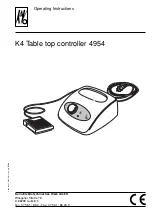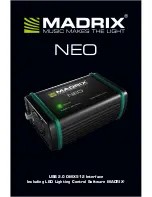
Introduction
The IRT 20 is an affordable, rugged, hand-cranked Megohmeter that is
ready to go when you are. Check motor and generator windings, pow e r
t ransformers, and electrical lines. It’s heavy - d u ty construction and multiple
output ranges make it suitable for a wide variety of applications, even in
harsh environments.
Features include
• 1000, 500 and 250 volt output ranges
• Sealed, water-resistant rugged metal housing
• Damping time exceeds 4 seconds
• Hand-crank power-supply
• Accurate to within one division
Safety Notes
Before using this i n s t r u m e n t, read all safety information carefully. In
this manual the word
"WARNING"
is used to indicate conditions
or actions that may pose physical hazards to the user. The word
"CAUTION"
is used to indicate conditions or actions that may
damage this instrument.
• Do not attempt to measure any voltage that exceeds the
ca t e g o ry based rating of this instrument
• Do not attempt to use this instrument if either the instrument or the
test leads have been damaged. Turn it in for repair at a qualified
repair facility
• Ensure instrument leads are fully seated prior to making
voltage measurements
• Keep your fingers away from the test lead’s metal probe
contacts when making measurements. Always grip the leads behind
the finger guards molded into the probes
Operating Instructions
Measuring Insulation Resistance
1. Check for voltage to make sure equipment has been taken out of
service and no static charge is present.
2. Connect the red test lead to the “
L
” terminal and the black test
lead to the “
E
” terminal.
3. For a circuit or phase to ground test, connect the red test lead to
the circuit or phase to be tested and black lead to ground.
4. For a circuit to circuit or phase to phase test, connect the red test
lead to one circuit or phase. In both instances it is important that
the circuit or phases are isolated from ground and each other.
5. Crank the generator at a constant speed.
NOTE:
It is not necessary to crank at an excessively fast speed.
After appropriate time lapse, depending on the type to test, read
the insulation resistance on the megohm scale at the completion
of the test. It is a good safety practice to ground the circuit with a
jumper wire before disconnecting the test leads.
Guard Circuit
The IRT 20 is equipped with a Guard Terminal and Guard Circuit that
a l l ows by-passing unwanted leakage current around the metering circuit.
Unwanted leakage current may be due to surface leakage or floating
metallic circuits, such as found in a multi-winding transformer or
multi-conductor cables, that provide a leakage path due to static charges.
This allows measuring insulation resistance of two particular circuits
without the influence of other resistive paths.
The Guard Terminal can be connected to the electrodes that are in contact
with the surface of the insulation. However, these electrodes should not
be connected to any circuits under test, and must be in contact with the
insulation only in order to intercept leakage current over the surface.
The Guard Terminal can also be connected to floating circuits such as
transformer windings not being tested, or circuits in a mult-conductor
cable not being tested. All windings or circuits should also be isolated
from each other and from windings or circuit under test.
M a i n t e n a n c e
Periodic Service
WARNING!
Repair and service of this instrument is to be performed by qualified
personnel only. Improper repair or service could result in physical
degradation of the meter. This could alter the protection from
electrical shock and personal injury this meter provides to the
operator. Perform only those maintenance tasks that you are
qualified to do.
These guidelines will help you attain long and reliable service from
your meter:
• When in use, the tester should be kept as far away as possible
from magnetic fields and in a level, stable position.
• When measuring, first rotate handle clockwise until speed increases
gradually up to approx. 150 RPM at which time the governor begins
to slip and steady readings may be taken
• The instrument should never be used in the vicinity of high
tension installations or during thunder and lighting storms
• Avoid continuous vibration of instrument to avoid damage
• Keep your i n s t r u m e n t dry. If it gets wet, wipe dry immediately.
Liquids can degrade electronic circuits
• Whenever practical, keep the i n s t r u m e n t away from dust and dirt
that can cause premature wear
• Although your instrument is built to withstand the rigors of daily
use, it can be damaged by severe impacts. Use reasonable caution
when using and storing the meter
Cleaning
Periodically clean your meter’s case using a damp cloth.
DO NOT
use
abrasive, flammable liquids, cleaning solvents, or strong detergents as
they may damage the finish, impair safety, or affect the reliability of the
structural components.
IRT20-MAN
P. 1






















